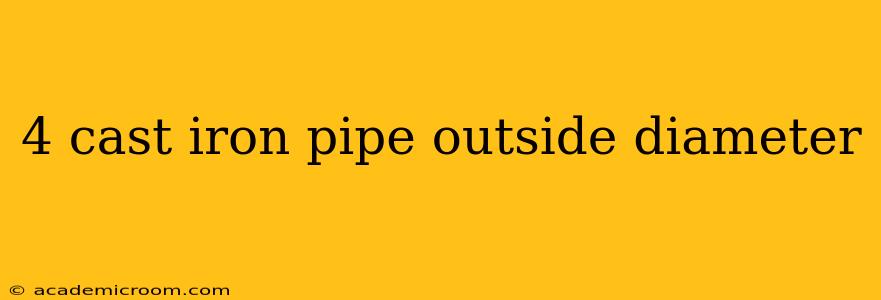4 Inch Cast Iron Pipe Outside Diameter: A Comprehensive Guide
Cast iron pipes, known for their durability and longevity, have been a mainstay in plumbing and drainage systems for generations. Understanding the precise dimensions of these pipes is crucial for accurate planning and installation. This guide focuses specifically on the outside diameter (OD) of 4-inch cast iron pipes, addressing common questions and providing valuable information for professionals and DIY enthusiasts alike.
While the nominal size of a pipe is often used (in this case, 4 inches), it's important to understand that this doesn't directly correspond to the actual outside diameter. The outside diameter can vary slightly depending on the pipe's manufacturing standards and age. However, we can provide a general understanding and address common variations.
What is the actual outside diameter of a 4-inch cast iron pipe?
The actual outside diameter of a 4-inch cast iron pipe is generally around 4.5 inches. This is a close approximation, and minor variations are possible depending on the manufacturer and the specific type of cast iron pipe (e.g., hub-and-spigot, flanged). Always check the manufacturer's specifications for precise measurements if accuracy is critical for your project.
What are the different types of 4-inch cast iron pipes?
Understanding the different types of 4-inch cast iron pipes helps clarify the potential variations in outside diameter. Common types include:
- Hub-and-spigot: This type features a bell-shaped end (hub) that fits over the plain end (spigot) of the next pipe section. The joint is sealed with lead or a modern sealant. The outside diameter measurement usually refers to the spigot end.
- Flanged: Flanged pipes have flanges at each end, allowing for easier connection and potentially providing a more robust joint. The outside diameter measurement might slightly differ depending on the flange dimensions.
- Mechanical Joint: This type uses a gasket and mechanical coupling for joining, often offering a quicker and easier installation than traditional hub-and-spigot. Again, the outside diameter measurement might vary slightly.
How does the outside diameter differ from the inside diameter?
The outside diameter (OD) is the measurement across the widest point of the pipe's exterior. The inside diameter (ID), on the other hand, measures the diameter of the pipe's internal bore. The difference between the OD and ID is the pipe's wall thickness. This wall thickness contributes significantly to the pipe's strength and pressure resistance. For a 4-inch cast iron pipe, the inside diameter will be smaller than 4 inches, reflecting the material thickness of the pipe walls.
What is the weight of a 4-inch cast iron pipe?
The weight of a 4-inch cast iron pipe varies depending on its length and the wall thickness. Cast iron is a dense material, and therefore, these pipes can be quite heavy. This weight is an important factor to consider when handling and transporting these pipes during installation. You should always consult the manufacturer's specifications for the exact weight of a specific pipe length.
Where can I find more precise measurements for a 4-inch cast iron pipe?
For precise dimensions, always refer to the manufacturer's specifications or datasheets. These documents will provide detailed information on the OD, ID, wall thickness, and weight for specific pipe types and lengths. Contacting a pipe supplier or plumbing professional is another excellent resource for obtaining accurate measurements for your project.
By understanding the nuances of 4-inch cast iron pipe dimensions and considering the variations among different types, you can ensure a successful and safe installation for your project. Remember that consulting manufacturer's specifications is always the best practice for achieving precision.
